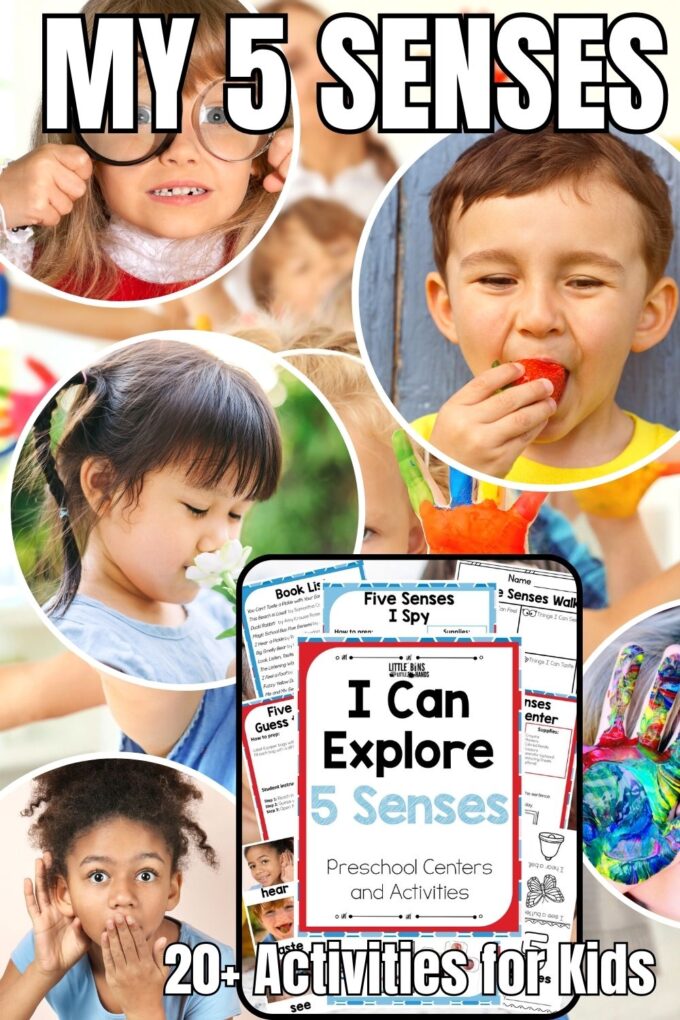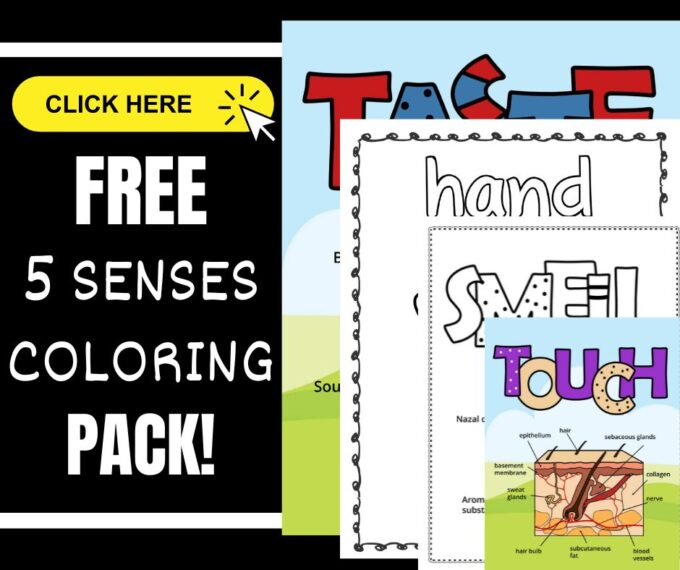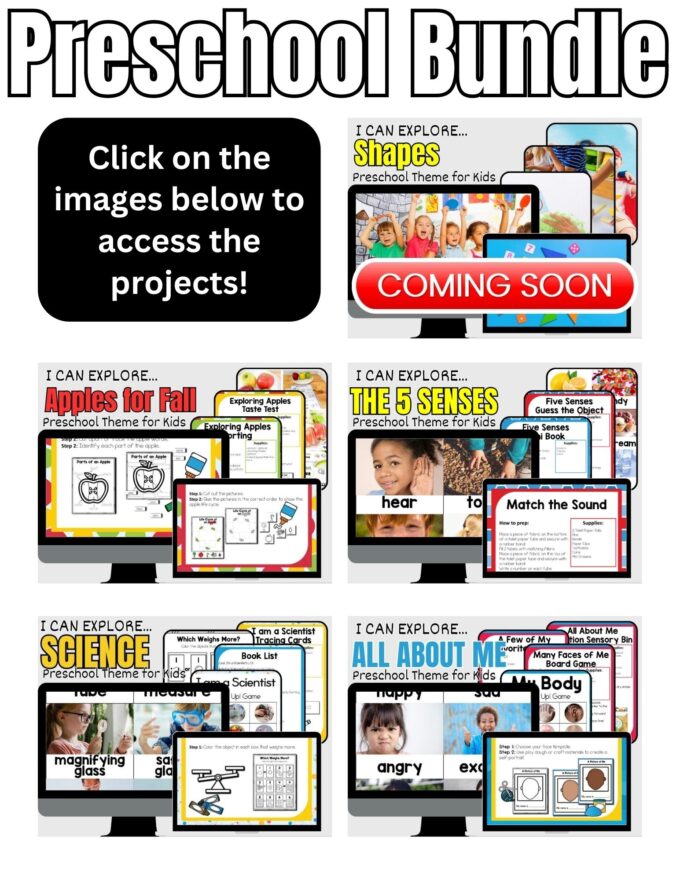Introduce the 5 senses to preschoolers with these hands-on and printable 5 senses activities. Great for adding to your preschool unit on exploring the body’s senses! What are the 5 senses? They are sight, taste, touch, sound, and smell! Learn about the world around you with activities that use all 5 senses, or focus on one at a time. An easy way to make preschool science activities playful, fun, and engaging! Discover the world together!

What are the 5 Senses?
If you are going to explore the 5 senses, you need to know what they are first! The 5 senses include touch, taste, sound, sight, and smell. These concepts are super easy to explore with junior scientists because we use our 5 senses every day in many ways.
The senses are how we explore and learn about the world around us. Textures and colors ignite our senses of touch and sight.
New foods and tasty goodies explore our sense of taste, even if they aren’t so tasty. Smells like peppermint or cinnamon bring back memories or make us feel more in tune with the season or holiday.
The wind rustling the leaves, the waves breaking on the shore, our footsteps walking along a wooded path, or the call of a bird overhead are fantastic opportunities for listening to our senses!
Take a look at our sensory science list to read more about combining science and sensory play as well engaging the 5 senses.
Why is Learning About the 5 Senses Important?
Learning about the five senses is important for preschoolers because it lays the foundation for their understanding of the world around them. The five senses — sight, hearing, touch, taste, and smell — provide essential information that helps kids make sense of their environment, interact with others, and develop various cognitive, social, and emotional skills.
Here’s why learning about the five senses is important for preschoolers:
Understanding The World
The five senses allow preschoolers to explore and understand the world around them. They learn to differentiate between objects, people, and experiences based on how they look, sound, feel, taste, and smell.
Creativity and Imagination: Learning about the five senses sparks creativity and imagination. Children can use their sensory experiences to invent stories, create art, and engage in imaginative play.
Development
Language Development: Learning about the five senses introduces children to new vocabulary and helps them express themselves more effectively. Describing sensory experiences enhances their language skills and enables them to communicate their thoughts and feelings.
Cognitive Development: Engaging with the five senses helps develop cognitive skills like observation, comparison, and categorization. Children learn to recognize patterns, similarities, and differences, which are essential cognitive processes.
Social and Emotional Development: The five senses play a role in social interactions. Children learn to read others’ emotions and intentions through facial expressions, body language, and tone of voice. They also develop empathy and consideration for others’ sensory preferences and sensitivities.
Fine and Gross Motor Skills: Engaging with their senses enhances both fine and gross motor skills. Activities like painting, drawing, building with blocks, and playing with different textures promote the development of hand-eye coordination and muscle control.
Introduces Science
Scientific Inquiry: Learning about the five senses provides a basic introduction to scientific inquiry. Preschoolers begin to ask questions about how things work, why they feel or taste a certain way, and how their senses help them understand the world.
Critical Thinking: Exploring their senses encourages preschoolers to think critically and make connections between their sensory experiences and the concepts they learn. They start to develop reasoning skills by asking questions like “Why does this smell different from that?” or “How come this tastes sour?”
Everyday Applications
Safety Awareness: Understanding their senses helps preschoolers stay safe. They learn to identify potential dangers based on sensory cues, such as recognizing the smell of something burning or the sound of an approaching vehicle.
Healthy Habits: Developing an awareness of their senses can encourage healthy habits. Preschoolers can learn to make healthy food choices based on taste and smell, and they can develop good hygiene practices that involve touch and smell.
Observation and the 5 Senses
Observation in science begins with using our senses to gather information about the world around us. It involves using science process skills, paying close attention to details, making careful notes or drawings, and using tools to help us make better observations.
Making observations is an essential skill in science because it leads to collecting data and gathering evidence to support or refute hypotheses down the track. Learn more about using the scientific method with kids.
Observing is also a good way for us to explore and learn about the natural world. Young children learn when they make observations in new situations, especially with science sensory experiences.
Let’s take a closer look at how kids can practice making observations using their 5 senses:
Sight
Observing through sight involves looking closely at objects and noting their color, shape, size, and patterns. For example; start a seed jar or grow crystals!
Hearing
Observing through hearing involves listening to sounds around them and identifying their source. Kids can listen to bird songs, the rustling of leaves, or the sound of raindrops. For example; try a water xylophone!
Touch
Observe through touch to explore the texture, temperature, and hardness of objects. Kids can touch different types of materials such as sand, water, feathers, or bark. Try making oobleck or slime.
Taste
Observing through taste involves exploring the flavors of different foods or substances. They can describe the tastes as sweet, sour, bitter, or salty. Try fizzy lemonade or a Candy Taste Test!
Smell
Observing through smell involves detecting and describe odors. Kids can explore different scents in their environment, such as flowers, fruits, or spices. For example; paint with spice paint!
List of 5 Senses Books
Read a book together and talk about the 5 senses. First, talk about what you can and can not touch. Next, talk about how you can see something and not hear it. Then, think of times you use more than one sense.
Here are some books about the 5 senses for you to enjoy. (I am an Amazon Affiliate)
You can find even more 5 Senses book suggestions in our printable 5 Senses preschool pack at the end!
You Can’t Taste a Pickle with Your Ear by Harriet Ziefert: Seeing, smelling, hearing, touching, tasting is there a child who doesn’t wonder how the five senses work?
This Beach is Loud! by Samantha Cotterill: But it can also be busy. And loud. Sand can feel hot or itchy or sticky… and it gets everywhere! In This Beach Is Loud!, a sensitive boy gets overwhelmed by all the sights, sounds, and sensations at the beach.
The Magic School Bus Explores the Senses by Joanna Cole: On a most sense-sational trip that takes them through an eye, an ear, a tongue, and even a dog’s nose, Ms. Frizzle’s class learns about the senses.
Look, Listen, Taste, Touch, and Smell: Learning About Your Five Senses (The Amazing Body) by Pamela Hill Nettleton: Seeing, hearing, smelling, tasting, touching ― our bodies do all kinds of amazing things! It’s a colorful introduction to the five senses ― sight, hearing, smell, taste, and touch ― and the organs that perform these functions. A must for any emerging science fan.
My 5 Senses (Let’s Read and Find Out) by Aliki: Sight, smell, taste, hearing, and touch—our five senses teach us about our world. Beloved author-illustrator Aliki’s simple, engaging text and colorful artwork show young readers how they use their senses to smell a rose or play with a puppy.
Get Your Free Printable 5 Senses Worksheets!
5 Senses Activities For Kids
Color Mixing Fun
What happens when you mix primary colors together? Set up three bowls of colored water – one with red, one with blue, and one with yellow. Provide small plastic droppers and white coffee filters. Get kids to mix different colors by using the droppers to combine the colored water on the coffee filters. What colors do they make? Combine with our printable color mixing worksheet.
Nature Scavenger Hunt
Getting kids outdoors and going on a nature walk is a great way to develop observation skills and appreciation for the natural world. Give kids a list of natural objects to find (e.g. a leaf, a rock, a flower). Encourage them to spot and collect each item with their keen sense of sight.
Rainbow Hunt
Introduce the concept of colors and light refraction with a rainbow hunt. Take kids outside on a sunny day and give them small mirrors. Encourage them to hold the mirrors at different angles and observe the rainbows formed by sunlight hitting the mirror’s surface. What colors can they see? Check out more simple ways to make a rainbow.
Shadow Puppets
Provide a flashlight and some small toys or cutouts. Have the children hold the toys in front of the flashlight to see the shadows they create. Experiment with moving the shadow puppets closer and farther away from the light to observe changes in the shadow’s size and shape. Grab our free printable to make your own shadow puppets.

DIY Kazoos
Learn about sound vibrations with your own homemade kazoos. Get kids to create their own kazoos using empty toilet paper rolls and wax paper. Show them how to cover one end of the roll with the wax paper and secure it with a rubber band. Then, have them hum into the open end to produce sound. Discuss how the vibrations of their humming create sound through the kazoo.
Musical Water Glasses
Explore the sense of sound with an easy to make water xylophone. Set up a few glasses with varying levels of water. Provide the children with plastic spoons and encourage them to tap the glasses gently. Let them observe and listen to the different pitches produced by each glass. Experiment with adding or removing water to see how it affects the pitch.
Nature’s Orchestra
What about listening for the sounds you can hear in nature? Go on another nature walk, but this time, focus on listening to the sounds around them with their eyes closed. Afterward, discuss what they heard and what is the sources of each sound, such as birds chirping or leaves rustling.
Sound Guessing Game
Explore the sense of sound with a fun sound guessing game. Gather various sound-producing objects, such as bells, shakers, and whistles, in a box. Blindfold one child at a time and have them pick an object from the box. They should make the sound without revealing the object’s identity. The rest of the children try to guess which object it is based on the sound it makes.

Sweet or Sour Taste Test
Prepare small cups with different liquids, some sweet (e.g., fruit juice) and others sour (e.g., lemon juice). Blindfold kids and have them taste each liquid. After tasting, ask them to identify if it was sweet or sour and discuss their findings as a group.
Exploring Taste Buds
This time explore the sense of taste with a wide variety of foods, and come up with different words to describe those flavors. Provide kids with various foods, such as salty crackers, sweet fruits, sour candies, and bitter vegetables. Ask them to categorize each food based on its taste. Then, have a discussion about taste buds and how they help us experience different flavors.
LOOK: Apple Taste Test and Candy Taste Test
Edible Soil Layers
Use the sense of taste to understand soil layers and what they are made of. Create edible “soil” cups by layering ingredients like crushed cookies (for rocks), chocolate pudding (for soil), and gummy worms (for worms). Let the children assemble their own cups, and as they eat, talk what each food represents and why it is important to the soil.
Mystery Tasting
Blindfold the children and offer them various small food items with distinct tastes (e.g., grapes, cheese, popcorn, raisins). Ask them to identify each food solely based on taste. Afterward, reveal the items and discuss how taste helps us distinguish different foods.

Sensory Textures
Put together a sensory table with various textures, such as sandpaper, fabric, sponges, and pebbles. Let the children touch and feel each item. Encourage them to describe the textures using rough, smooth, soft, and hard words.
Mystery Touch Bag
Place various objects with different textures (e.g., a soft plush toy, a rough rock, a squishy ball) in a bag. Have each child reach into the bag one by one to feel the mystery items without looking. Have them guess what they felt and discuss their experiences. See our Guess the Object game.
Sensory Nature Prints
During a nature walk, gather leaves, flowers, and other natural materials with interesting textures. Provide kids with playdough or clay and have them press the natural items into the material to create imprints. Discuss the textures they observe and how they differ from one another.
Hot or Cold
Set up containers with warm water and cold water. Provide spoons and cups, and let kids dip their hands into each container to feel the temperature differences. Discuss their observations and talk about the basic concepts of hot and cold.

Mystery Scents
Gather various items with distinct scents, such as coffee beans, citrus peels, and flowers. Place each item in separate, airtight jars. Let the children smell each jar without seeing the contents and try to guess what’s inside based on the scent.
Smelly Art
Engage the sense of smell while exploring creativity. Prepare a few containers with different scented paints or scented markers. Provide plain white paper and let the children create artwork using the scented materials. As they work, discuss the various scents and ask them to describe how each scent makes them feel. See how to make scented paint.
Scented Playdough
Make scented playdough using essential oils or natural scents (e.g., lavender, lemon, peppermint). Encourage kids to knead and play with the playdough, exploring the scents as they create different shapes and objects. See how to make apple scented playdough.
Fruity Smell Investigation
Use the sense of smell to explore how fruit decompose over time. Provide a variety of fruits with strong scents, such as bananas, oranges, and lemons. Have the children observe and smell each fruit. Over the course of a few days, revisit the fruits to observe how their scents change as they ripen or decompose, and talk about why that is.

Printable Preschool 5 Senses Pack
Get ready to explore this year with our growing Preschool STEM Bundle!
What’s Included:
There are 4 fun preschool themes to get you started. This is an ” I can explore” series!
- My 5 Senses
- All About Me
- Science and Scientist
- Apples
Each unit contains approximately 15 activities, with instructions and templates as needed. Hands-on activities are provided to keep it fun and exciting. This includes sensory bins, experiments, games, and more! Easy supplies keep it low cost and book suggestions add the learning time.









